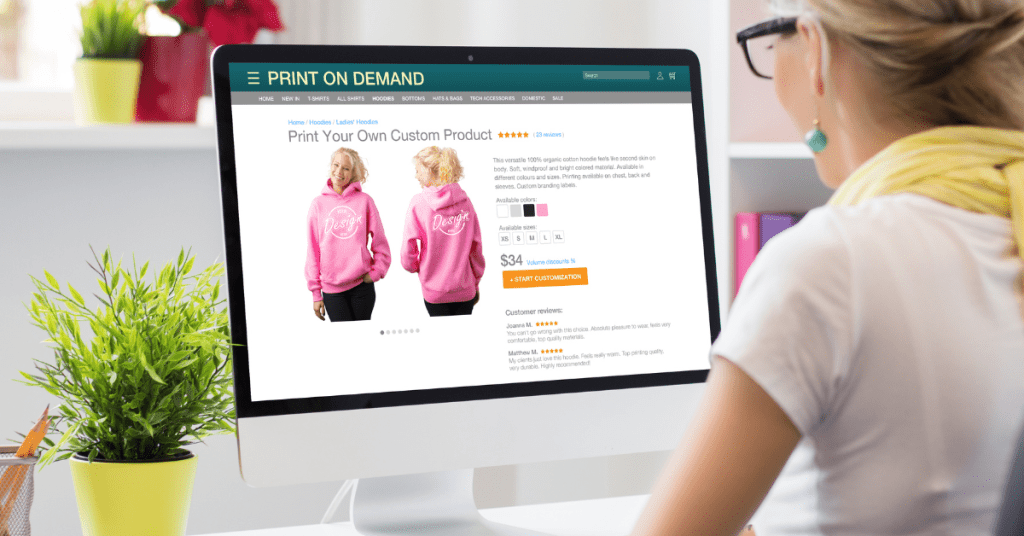Are you venturing into the exciting world of print-on-demand (POD) but feeling a bit overwhelmed by the potential pitfalls? Whether you’re a new or experienced entrepreneur, navigating the landscape of POD can be tricky without the right knowledge and guidance. In this comprehensive guide, we’ll explore into 17 Print-on-Demand mistakes commonly made in the print-on-demand industry and provide actionable strategies to help you sidestep these pitfalls.
Whether you’re considering launching a new POD store or looking to optimize an existing one, learning from these Print-On-Demand Mistakes can be the key to unlocking success in your e-commerce journey.
In overall, we can separate it into two different Print-On-Demand Mistakes. Design mistakes and Online store or marketing mistakes.
Start Your Print-On-Demand Store Today for Free
Design Mistakes – Print-On-Demand Mistakes
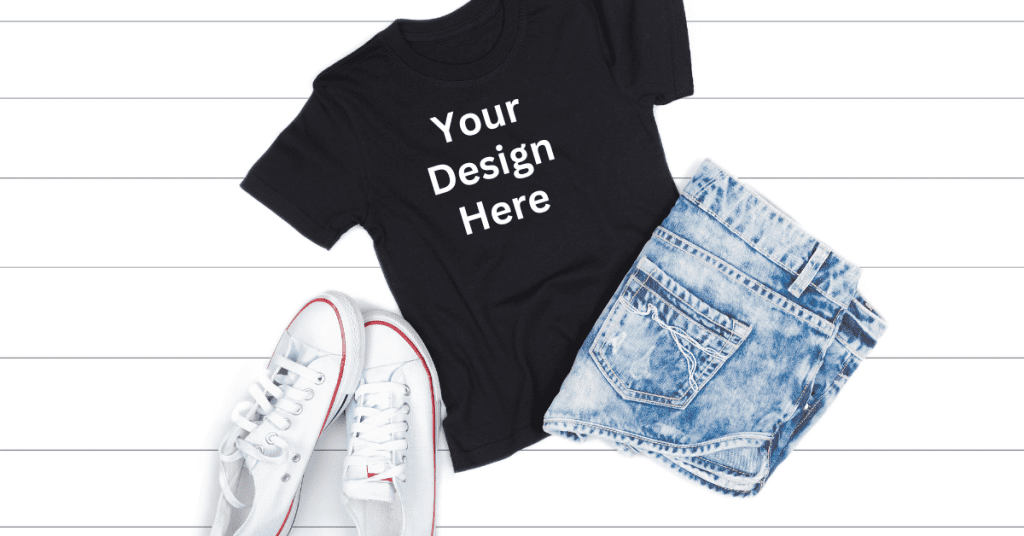
Getting a winning design is one of the most important in building a successful print on demand store. You can have 100 failed designs, but with just 1 successful design, your store will explodes.
Here’s some common Print-On-Demand Mistakes when it comes to design for your POD products.
1. Not Researching and Understanding Your Niche – Print-On-Demand Mistakes
You have the vision, the expertise, and the tools needed to transform your design into a successful product. But what else is crucial for achieving that success? The answer lies in identifying and understanding your target audience, also known as your niche in the world of ecommerce.
Designing a best-selling product becomes challenging when you lack clarity about who your product is intended for. Each audience has its unique interests, preferences, shopping behaviours, and pain points that your product can address. Failing to cater to these specific needs can result in creating a product that appeals only to you, without any customer demand.
If you’ve ever developed a product that doesn’t resonate with a specific audience, you’re not alone. In fact, 27% of respondents in our survey indicated that this oversight significantly impacted their businesses negatively.
Instead, developing a clear understanding of your ideal customer makes it much easier to refine your design. Furthermore, investing adequate time in audience research early on will streamline your marketing efforts when it’s time to promote the product.
On the other hand, understanding your audience’s demographics, interests, and purchasing behaviour is key to crafting designs that resonate emotionally and practically. This knowledge will influence your choice of product types, colour palettes, and messaging.
Besides, you should conduct thorough market research, analyse trends within your niche, and consider creating customer personas to refine your focus. By delving deep into your potential customers’ psyche, you’ll be better equipped to design products that are not just visually appealing but also highly relevant to your target audience.
This approach will foster stronger customer loyalty and drive higher conversion rates as your products consistently meet the needs and desires of your audience.
2. Pick the Wrong Product For Your Design – Print-On-Demand Mistakes
Not every design is suitable for every type of product. Even if your design is tailored to impress your niche audience, selecting the right products to showcase it on is equally important.
Here are some key tips to consider when choosing print-on-demand products:
Relevance to Your Niche Audience
Avoid selecting products solely based on cost or profit margins. Instead, prioritize products that resonate with your specific audience’s needs and interests. For example, promoting enamel mugs or rain jackets would make sense for campers but might not be relevant for movie lovers.
Seasonal Alignment
Match seasonal designs with products appropriate for that time of year. For instance, fall-themed designs can be printed on cozy blankets and warm hoodies, while vacation-inspired designs are perfect for beachwear, tank tops, and flip flops.
Opt for All-Over Print for Patterns
All-over printing is ideal for designs with intricate patterns as it covers the entire garment without leaving any white space. This method offers more creative freedom compared to constrained printing areas. To find such products, select a category like men’s t-shirts, then apply filters for “Cut & sew sublimation.”
Utilize Photography for Posters
If your designs involve photography, consider printing them on posters or canvases. This approach ensures sharper and more detailed results compared to wearable garments.
Choose DTG Printing for Typography and Graphics
Direct-to-garment (DTG) printing is perfect for designs featuring graphics or text. This method involves spraying ink directly onto the garment, allowing for highly detailed designs without color limitations.
Prefer Embroidery for Durability
For products that will undergo frequent washing, such as work uniforms (e.g., custom t-shirts, hoodies, aprons, towels), opt for embroidery. Embroidered designs hold up well over time, maintaining their quality and appearance even after multiple washes. While DTG prints are durable with proper care, fabrics with darker or vivid colors may gradually fade due to ink absorption.
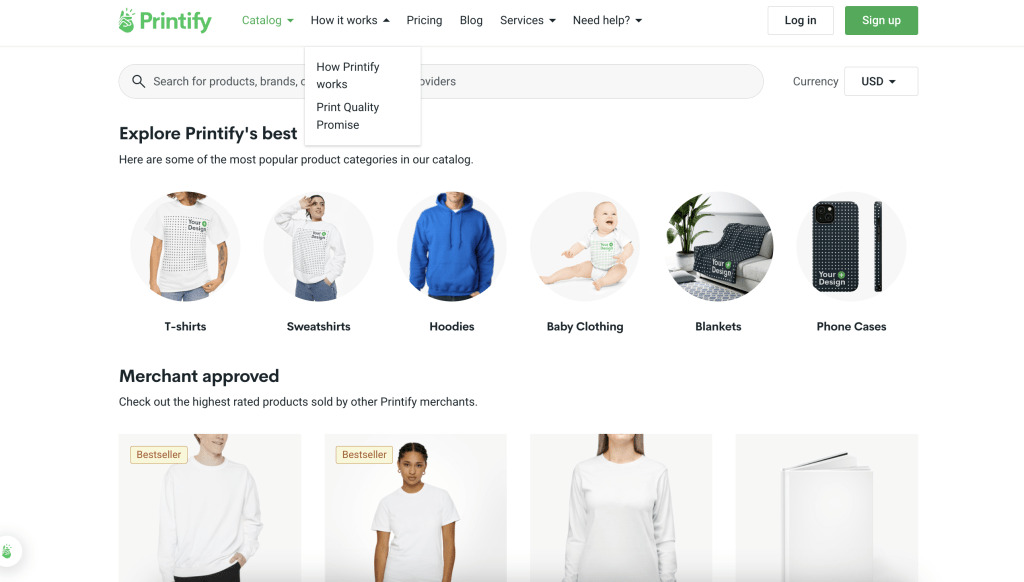
By strategically selecting print-on-demand products that align with your niche audience and complement your design elements, you can enhance the appeal and effectiveness of your offerings. This thoughtful approach ensures that your designs are not only visually appealing but also practical and durable for your target market.
Start Your Print-On-Demand Store Today for Free
3. Research about Your Competitors – Print-On-Demand Mistakes
A common mistake among beginners is assuming what an audience wants instead of conducting thorough research to understand their genuine needs. Rather than relying on guesswork, you can assess existing market offerings to draw informed conclusions about what resonates best with your target audience.

Researching competitors’ designs before creating your own can provide valuable insights into:
- Popular Design Elements: Analyze the prevalent colours, fonts, and design styles within your niche. Understanding these preferences will guide you in creating designs that appeal to your audience’s aesthetic tastes.
- Product Availability and Gaps: Explore the range of products available in your niche market and identify any gaps or underserved areas. This knowledge can inspire you to introduce unique and innovative offerings that address unmet needs.
- Pricing and Marketing Strategies: Study how similar designs are priced and marketed. This information will help you establish competitive pricing strategies and develop effective marketing campaigns.
For instance, suppose you intend to sell custom gifts for teachers. Start by conducting a simple search on platforms like Etsy, Amazon, or Redbubble using keywords like “custom gifts for teachers.” Take note of the top-ranking products and assess what makes them stand out from the competition. More importantly, brainstorm ways to enhance your designs to surpass existing offerings in terms of quality and appeal.
By leveraging competitor research effectively, you can gain actionable insights that inform your design and business strategies. This proactive approach not only minimizes guesswork but also positions your products more strategically in the market, increasing their chances of success.
4. Copying Other’s Designs – Print-On-Demand Mistakes
Printing someone else’s intellectual property without proper authorization exposes you to potential legal repercussions due to copyright infringement. Beyond legal risks, there’s the practical issue of wasting time developing products that print-on-demand services may refuse to produce.
To successfully print merchandise, it’s imperative that you have rightful ownership of the content you submit or possess explicit rights to utilize, display, and resell it. Familiarize yourself with Copyright and Trademark and Acceptable Content Guidelines to confirm that your designs align with our stipulated criteria. This diligence ensures a smooth and compliant experience when utilizing our services for your printing needs.
Start Your Print-On-Demand Store Today for Free
5. Low Quality Design File and Size – Print-On-Demand Mistakes
The quality of your printed products hinges significantly on the print and embroidery files you provide. Neglecting crucial aspects such as file resolution, colour accuracy, and transparency adherence inevitably results in diminished quality outcomes.

There’s a plenty of potential errors that can occur with print files, but several common ones stand out:
- Low-Resolution Images: Submitting images with low resolution leads to pixelation and blurry prints.
- Improper Background Removal: Failure to adequately remove backgrounds can result in unwanted elements appearing in the final design.
- Transparency Issues: Improper use of transparency can cause unexpected effects in the print, impacting the overall appearance.
- Tiny Text: Including text that is too small can make it illegible or indistinct in the final product.
- Use of Fade, Glow Effects, or Neon Colors: These effects might not translate well to print and can result in color discrepancies or unexpected appearances.
To ensure optimal quality and avoid potential printing issues, it’s crucial to adhere to file specifications and guidelines. Paying attention to details like image resolution, background removal, transparency settings, and design elements will help deliver the high-quality merchandise you envision.
6. Not Ordering Product Samples – Print-On-Demand Mistakes
Selling products you’ve never physically seen is a mistake commonly made by newcomers in the industry. Many beginners believe that relying solely on mockups suffices, viewing physical samples as an unnecessary expense. However, this perspective is quite misleading.
There are several compelling reasons why procuring samples is an essential step that cannot be overlooked. Ordering samples allows you to thoroughly assess various aspects:
- Assess Design Quality: By examining physical samples, you can evaluate the actual quality of the design, including materials used, stitching, and overall craftsmanship. This firsthand evaluation ensures that the final product meets your standards.
- Evaluate Fit and Comfort: Trying on the garment yourself or having others test it helps determine how it fits and feels. Understanding the fit is crucial for customer satisfaction and reduces the risk of returns or negative reviews.
- Capture Authentic Product Photos: Authenticity is key in marketing. Having real samples allows you to create genuine product photos that accurately represent your merchandise. This authenticity builds trust with your customers.
- Provide Informed Customer Support: When customers inquire about your products, having personal experience with samples allows you to answer questions confidently and accurately. This builds credibility and enhances the customer experience.
Reliance solely on mockups can be deceiving. The true quality and appearance of your products may differ significantly from what is depicted virtually. Failing to assess physical samples can lead to dissatisfied customers and damage your brand’s reputation.
Start Your Print-On-Demand Store Today for Free
7. Look for Feedback and Review – Print-On-Demand Mistakes
The biggest product design mistake is failing to ask for feedback on their designs. A staggering 71% of respondents believe that this oversight has had a negative impact on their businesses.
Many beginners shy away from seeking feedback for various reasons. Some are unsure of whom to approach, while others hesitate to share their ideas out of fear of theft or lack of confidence. However, it’s crucial to recognize that a design is rarely perfect on the first attempt, making soliciting feedback essential for improvement.
So, how can you effectively gather feedback?
- Engage Online Communities: Identify relevant Reddit threads, Facebook groups, or Discord channels frequented by your target audience. Share a photo of your product and ask for opinions. Engaging with these communities is straightforward and cost-effective.
- Seek Constructive Criticism: Encourage users to provide constructive criticism. Specific questions can prompt useful feedback, such as asking about colour choices, design elements, or overall appeal.
- Embrace Feedback as a Growth Opportunity: View feedback as an opportunity for growth rather than a critique. Constructive criticism can highlight areas for improvement and guide you toward refining your designs.
- Iterate Based on Feedback: Act on the feedback received by making iterative improvements to your designs. Continuously refining your products based on input will enhance their market appeal and increase sales potential.
Seeking feedback is not only beneficial but also essential for product development. By leveraging online communities, you can access valuable insights that will empower you to create designs that resonate with your audience and drive business success.
Start Your Print-On-Demand Store Today for Free
Online Store and Marketing Mistakes – Print-On-Demand Mistakes
Once your designs are ready, it’s time to sell your product. You can sell it on an online marketplace like Etsy or build your own eCommerce store on a platform like Shopify.
Either way, the customer experience and your sales process is important to get more sales and increase your cart value.
1. Not Choosing The Right Ecommerce Platform
Your print-on-demand store’s foundation lies in the ecommerce platform you select. This platform not only serves as the virtual storefront where you manage listings but also defines the appearance and functionality of your entire store.
When you opt for an ecommerce platform, you are making a significant commitment to its regulations, expenses, and constraints. One common pitfall is hastily choosing a platform without thorough research, only to discover later that it fails to align with your specific needs or financial plan.
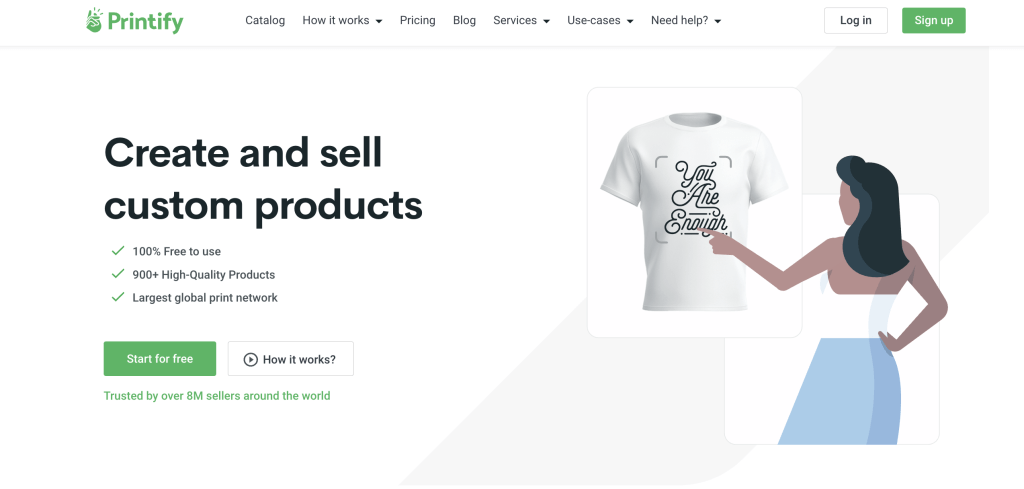
If you have opted for Printify as your print-on-demand service provider, you have an extensive selection of over 20 ecommerce platforms to integrate with. However, determining the best fit for your store ultimately rests on your unique requirements. Here are essential considerations to ponder before finalizing your choice:
Store Setup Time
Evaluate how quickly and easily you can establish your store on the platform. A streamlined setup process can save time and effort, especially for beginners.
User-Friendliness
Consider the platform’s user interface and accessibility. Is it beginner-friendly? A user-friendly platform can simplify operations and reduce the learning curve.
Cost Structure
Examine the monthly fees and transaction charges associated with the platform. Ensure they align with your budget and revenue projections to avoid unexpected financial burdens.
Payment Gateway Options
Investigate the available payment gateway services on the platform. A diverse range of payment options can enhance customer convenience and expand your market reach.
Design Capabilities
Assess the design features offered by the platform. Look for customization options, responsive templates, and other design tools to create a visually appealing and functional storefront.
2. Bad eCommerce Store Design
The presentation and functionality of your website play important roles in converting visitors into customers. It’s essentially the face of your business in the digital world.
While there are limited customizations you can have if you are selling on a marketplace, you can always leverage on what’s available and make your store professional.
Let’s get into key design principles for online stores that can significantly impact your sales:
Simplify Navigation
The navigation of your online store should be intuitive and easy to understand. You should opt for conventional navigation patterns that users are familiar with. In addition, avoid overly complex structures that may confuse or frustrate visitors. Instead, you should make it easy and fast for your customers to access to information and products they need. This can lead to quicker conversions.
Streamlined Checkout Process
A seamless checkout experience is crucial for minimising cart abandonment rates. You canimplement a one-step checkout process whenever possible. Lengthy or convoluted checkout procedures can deter customers. Research shows that a significant percentage of online shoppers abandon their carts due to checkout complexities.
This is where a sales funnel comes in where the customers can complete their purchase within just 3 steps and the upsell sales will complete with just a single click of the button.
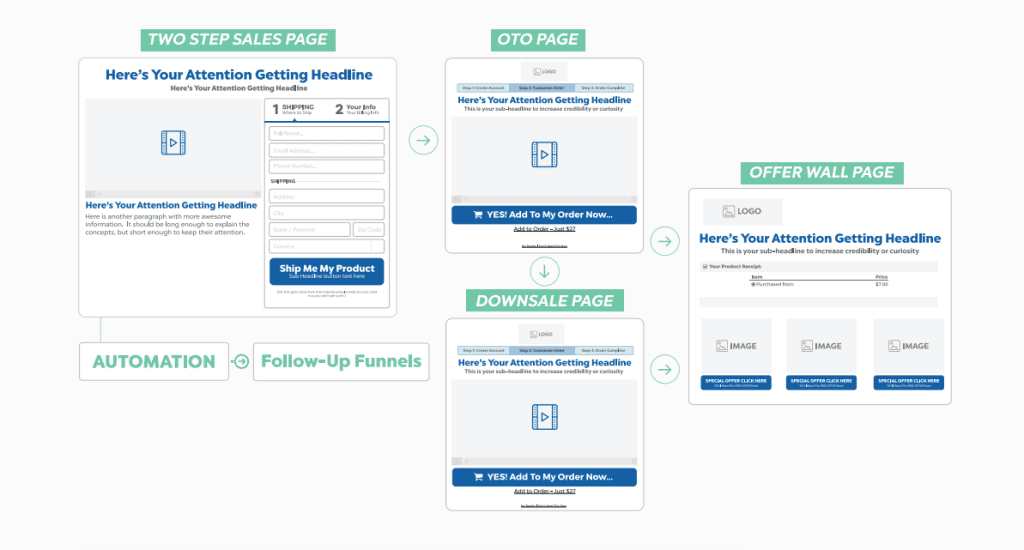
Ensure Mobile-Friendliness
Mobile compatibility is non-negotiable in today’s digital landscape. Utilize Google’s Mobile-Friendly Test to verify your website’s responsiveness on mobile devices. Additionally, consider developing a dedicated mobile version of your ecommerce store to optimize the user experience for smartphone users.
Optimize Website Speed
Fast-loading pages enhance user satisfaction and positively influence search engine rankings. You need to conduct regular performance assessments and implement optimizations to boost your website’s speed. This includes compress images, leverage browser caching, and eliminate unnecessary scripts to achieve optimal loading times.
Offer Diverse Mobile Payment Options
Cater to the preferences of mobile shoppers by providing multiple payment alternatives. Popular mobile payment solutions like Apple Pay, Google Pay, and digital wallets should be integrated into your checkout process. This flexibility can expedite transactions and enhance customer convenience.
Start Your Print-On-Demand Store Today for Free
3. Wrong Pricing Strategy For The Product
Pricing the products either too low or too high significantly affected the businesses in a negative way. Although determining the ideal price point for your products can indeed be a process of trial and error, but it’s a crucial aspect of running a successful business.
To help navigate this challenge, here are some key guidelines to keep in mind:
Firstly, avoid the temptation to compete solely on price. Instead of immediately comparing your prices to competitors, establish a sustainable base price that ensures you won’t be operating at a loss. This requires a comprehensive understanding of your costs and profit margins.
When evaluating product costs, it’s important to consider various factors. You should take into account not only production costs but also design and shipping expenses. Additionally, factor in transaction fees and taxes that may impact the final price of your product.
Furthermore, don’t overlook fixed costs such as domain registration fees and charges associated with your ecommerce platform. These expenses are often recurring and can impact your overall pricing strategy.
By adopting these guidelines, you can better position yourself to set competitive and sustainable prices that align with your operational needs and financial objectives. Balancing pricing strategy with cost considerations is essential for achieving profitability and long-term success in the marketplace.
4. Unclear Shop Terms and Policies
It is essential for businesses to ensure that customers can easily locate and understand their store policies. Contrary to the belief that “no one reads policies,” these guidelines are crucial for managing customer expectations and resolving potential issues effectively.
Customers should be aware of what happens if a parcel is lost during shipping, what to do if a purchased garment doesn’t fit, or how to address quality-related concerns. Clearly communicating these details in your store’s policies is key.
To enhance customer experience and build trust, all necessary policies such as Shipping, Returns, Exchanges, and Privacy, along with Terms and Conditions, should be prominently displayed and easily accessible on your website. This accessibility not only informs customers but also demonstrates transparency and professionalism.
When customers know what to expect and how their concerns will be addressed, they are more likely to feel confident and comfortable making purchases from your store. Clear and accessible policies contribute significantly to fostering positive relationships with customers and ultimately improving the overall shopping experience.
Start Your Print-On-Demand Store Today for Free
5. Bad Product Descriptions
The primary objective of a product description is to be informative and comprehensive. This provides customers with all the essential details they need in a concise manner. This includes key information such as sizing options, available colours, materials used, care instructions, production and shipping timelines, as well as shipping carrier details and links to your store’s policies. By ensuring that these fundamental aspects are covered, customers can make informed decisions about their purchases.
Once the basic information is conveyed, you can inject creativity into the description to make it engaging. The ultimate goal of a product description is to convert browsing users into paying customers.
To achieve this, consider the following strategies:
- Use Power Words: Incorporate emotive language to evoke feelings and desires related to the product. Power words can create a sense of urgency or excitement, encouraging users to make a purchase.
- Utilize Bullet Points: Organize information using bullet points rather than lengthy paragraphs. Bullet points are easier to scan and highlight key features effectively.
- Avoid Overly Wordy Descriptions: Keep the description concise and to the point. Avoid unnecessary fluff that may distract or overwhelm potential buyers.
- SEO Optimization: Optimize your product descriptions with relevant keywords to improve visibility and search engine ranking. This helps potential customers find your products more easily through online searches.
- Avoid Duplicate Content: Refrain from copy-pasting product descriptions across multiple listings. Duplicate content can negatively impact search engine rankings and may lead to confusion among customers.
6. Low-quality or Common Product Images
When it comes to online shopping, the impact of product images on customer purchasing decisions cannot be overstated. High-quality photos play a crucial role in helping buyers assess various aspects of a product. This includes fabric texture, print quality, colour accuracy, sizing, and overall fit. Beyond functionality, product images also serve as a powerful medium to convey your brand’s unique vision and identity.
While using generic mockups is common, solely relying on them represents a missed opportunity. Instead, by creating your own product photos, you can significantly enhance your brand’s appeal and authenticity. Contrary to the misconception that professional photography requires expensive equipment, you can achieve impressive results with minimal investment. Begin by ordering product samples and using your smartphone to capture images.
We had built a successful store and even online course with all the images, videos and courses recorded with a smartphone only. With your phone and the right editing app, it’s more than enough for you to get started.
Popular photography formats like selfies, mirror shots, and flatlays resonate well with social media users. These formats not only showcase products in realistic settings but also help potential customers connect with your brand’s narrative. By leveraging such visuals, you can effectively communicate your brand’s story and establish a relatable and engaging online presence.
Start Your Print-On-Demand Store Today for Free
7. Not Optimizing for SEO
SEO, or search engine optimization, is a method aimed at improving your website’s ranking on search engines like Google, thereby increasing organic traffic. Content plays an important role in capturing Google’s attention. This includes elements such as product descriptions, photos, the About Us page, and homepage.
Besides, if you are selling on marketplace, this would be how your products can appear at the top of the search result when someone searches on your product related keywords. Hence, it is very important that you products show up at the top of the search result so you get more visibility and sales.
To effectively leverage SEO for your ecommerce site, consider the following steps:
- Keyword Research: Identify relevant keywords specific to your niche that potential customers are likely to use in their searches. Tools like Google Keyword Planner or SEMrush can assist in this process.
- Optimize Listing Titles, Descriptions, and Tags: Incorporate your researched keywords strategically into your product titles, descriptions, and tags. This helps search engines understand the relevance of your content to user queries.
- Develop Quality Content: Create compelling and informative content, both written and visual, that engages your audience. This not only attracts visitors but also encourages them to stay on your site longer, improving SEO metrics like bounce rate and session duration.
- Collect and Showcase Reviews: Encourage customers to leave reviews and testimonials. Positive reviews not only build trust but also contribute to better search engine rankings. Keep the scores high by addressing customer feedback promptly and professionally.
- Build Backlinks: Establishing quality inbound links from reputable websites to your own can significantly boost your site’s authority and credibility in the eyes of search engines.
8. Neglect Marketing
One of the most common Print-On-Demand Mistakes new online store owners make is neglecting to market their products effectively. Despite dedicating considerable time to building a polished store and create an extensive product lineup, many beginners overlook the crucial step of implementing a robust marketing strategy. This oversight can lead to unrealistic expectations of immediate success without the necessary effort to attract visitors and generate sales.
Achieving that first sale hinges on effective marketing. To convert potential customers into paying clients, it’s essential to have a well-defined marketing plan in place. Such a strategy ensures that promotional efforts are purposeful, focused, and aligned with specific business objectives.
A solid marketing strategy serves several important purposes:
- Setting Measurable Goals: It provides a framework for establishing clear and measurable business objectives. By defining achievable goals, you can track progress and evaluate the success of your marketing efforts.
- Defining Target Market: It helps in identifying and understanding your target audience more effectively. By defining specific demographics, behaviors, and preferences, you can tailor your marketing campaigns to resonate with potential customers.
- Standing Out from Competition: A well-crafted marketing strategy enables your business to differentiate itself in a competitive market. Highlighting unique selling points and value propositions helps attract and retain customers.
Developing a marketing strategy doesn’t have to be daunting. It can start with asking the right questions and jotting down key insights. By gaining a strategic overview of your marketing approach, you can experiment with different tactics to gauge effectiveness and refine your approach over time. It’s crucial to align these efforts with the overarching vision and long-term goals of your brand.
Start Your Print-On-Demand Store Today for Free
9. Not Fully Utilize Social Media
Enhancing your brand’s online success hinges significantly on your strategic use of social media. This dynamic tool has the potential to draw in customers, and the effort you invest will directly correlate with the results you achieve.
So, how can you harness the full potential of social media? Here are some insightful tips to optimize your approach:
Maintain Consistency
Social media offers a unique opportunity to cultivate genuine relationships with your audience. Building trust requires consistent presence: post regularly, actively engage with comments, and promptly respond to inquiries. Consistency is key. You need to avoid skipping posts simply due to lack of motivation. Hence, you should establish a posting schedule to ensure consistency. This schedule provides a clear roadmap of content ideas and publication dates, even offering backup content for days when creativity is lacking.
Leverage User-Generated Content (UGC)
UGC is not only authentic and effortless to generate, but it also serves as compelling social proof that can sway potential customers towards your brand. If you’re not actively gathering reviews and content from your audience, you’re missing out on a valuable (and free) content resource. Encourage your followers to share their experiences, photos, and videos, and make it a routine to showcase UGC.
Prioritize Quality Over Quantity
Posting excessively throughout the day is not essential. Instead, focus on creating one outstanding piece of content daily. Quality content resonates more with your audience and tends to garner higher reach and engagement than multiple lower-quality posts.
Selectively Choose Social Platforms
With numerous social media platforms available, it’s unrealistic for a print-on-demand business, especially if you’re operating solo or with a small team, to maintain a strong presence across all platforms consistently. Instead of spreading yourself thin, focus on mastering a select few platforms that align best with your brand.Identify which platforms your target audience frequents the most, and tailor your content accordingly. By concentrating your efforts, you can create more meaningful interactions and yield better results than a scattered approach across multiple platforms.
10. Not Analyzing The Store Performance Data
Understanding and optimizing your online store’s performance doesn’t require a background in data analytics. By assessing what strategies have been successful and what hasn’t, you can make informed decisions about the next steps for your business.
Analytics plays a crucial role in deciphering customer behaviour. It will enable you to plan product launches and marketing campaigns more effectively. To gauge your online store’s performance, consider evaluating the following key metrics:
Website Traffic
This metric reveals the number of visitors your website attracts. Monitoring website traffic can provide insights into the effectiveness of your marketing efforts and overall online presence.
Conversion Rate
The conversion rate represents the percentage of website visitors who complete a desired action, such as making a purchase. Understanding and improving this metric is essential for optimizing your sales funnel.
Average Order Value
Calculated by dividing total revenue by the number of orders, the average order value indicates the average amount spent by customers per transaction. Increasing this value can significantly impact your profitability.
Cart Abandonment Rate
This metric reflects the percentage of visitors who initiate the checkout process but do not complete the purchase. Addressing factors contributing to cart abandonment can help reduce lost sales and improve overall conversion rates.
To effectively track and collect this data, utilize the following tools:
1. Google Analytics: Google Analytics is a powerful tool for tracking website traffic, user behavior, and engagement. It provides comprehensive insights into visitor demographics, sources of traffic, and more.
2. Google Search Console: This free tool from Google focuses on SEO performance. It helps you monitor your website’s visibility in Google search results, identify keywords driving traffic, and optimize your site’s performance for search engines.
3. Ecommerce Platform Dashboard: Your ecommerce platform’s dashboard is a valuable resource for analyzing conversion metrics. It typically provides detailed information on sales performance, customer behavior, and transaction data.
By leveraging these tools and monitoring key metrics regularly, you can gain actionable insights to refine your online store’s strategies and drive business growth. Remember, data-driven decisions are instrumental in optimizing performance and achieving sustainable success in e-commerce.
Final Thoughts: 17 Print-on-Demand Mistakes and How to Avoid Them
As we wrap up, it’s important to reflect on the valuable insights gained along this journey.
Avoiding these common Print-On-Demand Mistakes isn’t just about minimizing errors. Instead, it’s about maximizing your potential for success in the competitive world of e-commerce. By understanding the nuances of design, production, marketing, and customer engagement, you’re poised to build a robust and sustainable print-on-demand business.
As you apply the lessons learned from this guide, keep experimenting, refining, and evolving your approach. Embrace creativity, stay attuned to market trends, and prioritize customer satisfaction. With dedication and a commitment to continuous improvement, you’ll navigate the print-on-demand landscape with confidence and achieve your business goals.





